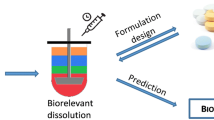Abstract
To achieve time-controlled or site-specific drug delivery in the gastrointestinal tract, a sigmoidal release system (SRS) was developed, which achieved a prolonged lag time, followed by rapid release. The theophylline beads with a thick Eudragit RS film coating showed very low drug release in water, whereas the release rate increased considerably in organic acid solutions. A hydration study of Eudragit RS films suggested that the increase in drug release was attributable to structural changes of the film induced by polymer-acid interactions. When succinic acid was incorporated into the core of Eudragit RS-coated theophylline beads, the drug release profile showed a typical sigmoidal pattern. SRS beads containing acetaminophen were also prepared by the same technique. Again, a sigmoidal release pattern was observed in which the lag time was prolonged with an increase in the coating level, whereas the drug release rate thereafter was almost constant irrespective of the coating level. Acetaminophen-containing SRS beads with different coating thickness were orally administered to beagle dogs. The drug plasma concentration curves showed lag periods similar to the in vitro lag time.
Similar content being viewed by others
REFERENCES
G. M. Zentner, G. A. McClelland, and S. C. Sutton. Controlled porosity solubility-and resin-modulated osmotic drug delivery systems for release of diltiazem hydrochloride. J. Control. Release 16:237–244 (1991).
G. Ragnarsson, A. Sandberg, M. O. Johansson, B. Lindstedt, and J. Sjögren. In vitro release characteristics of a membranecoated pellet formulation—influence of drug solubility and particle size. Int. J. Pharm. 79:223–232 (1992).
P. J. Watts, M. C. Davies, and C. D. Melia. Encapsulation of 5-aminosalicylic acid into Eudragit RS microspheres and modulation of their release characteristics by use of surfactant. J. Control. Release 16:311–318 (1991).
M. Ichikawa, S. Watanabe, and Y. Miyake. A new multiple-unit oral floating dosage system. I. Preparation and in vitro evaluation of floating and sustained-release characteristics. J. Pharm. Sci. 80:1062–1066 (1991).
M. A. Longer, H. S. Ch'ng, and J. R. Robinson. Bioadhesive polymers as platforms for oral controlled drug delivery. III. Oral delivery of chlorothiazide using a bioadhesive polymer. J. Pharm. Sci. 74:406–411 (1985).
V. H. K. Li, V. H. L. Lee, and J. R. Robinson. Influence of drug properties and routes of drug administration on the design of sustained and controlled release systems. In J. R. Robinson and V. H. Lee (eds.), Controlled Drug Delivery, Marcel Dekker, New York, 1987, pp. 3–94.
J. T. Flaherty. Nitrate tolerance: a review of the evidence. Drugs 37:523–550 (1989).
P. D. Goldenheim, E. A. Conrad, and L. K. Schein. Treatment of asthma by a controlled-release theophylline tablet formulation: a review of the North American experience with nocturnal dosing. Chronobiol. Int. 4:397–408 (1987).
H. Maekawa, Y. Takagishi, and Y. Doi. Gastrointestinal transition of enteric-coated aspiring granules: Gastrointestinal transition and absorption of pharmaceutical preparation (2). Yakuzaigaku 30:102–110 (1970).
K. Yamaoka, Pharmacokinetic Analysis Using Microcomputer, Nankoudo, Tokyo, 1983, pp. 113–139.
M. R. Jenquin, S. M. Liebowitz, R. E. Sarabia, and J. W. McGinity. Physical and chemical factors influencing the release of drugs from acrylic resin films. J. Pharm. Sci. 79:811–816 (1990).
R. S. Okor. Effect of polymer cation content on certain film properties. J. Pharm. Pharmacol. 34:83–86 (1982).
H. Yasuda and C. E. Lamaze. Permselectivity of solutes in homogeneous water swollen polymer membranes. J. Macromol. Sci.-Phys. B5 11:111–134 (1971).
Author information
Authors and Affiliations
Rights and permissions
About this article
Cite this article
Narisawa, S., Nagata, M., Danyoshi, C. et al. An Organic Acid-Induced Sigmoidal Release System for Oral Controlled-Release Preparations. Pharm Res 11, 111–116 (1994). https://doi.org/10.1023/A:1018910114436
Issue Date:
DOI: https://doi.org/10.1023/A:1018910114436




